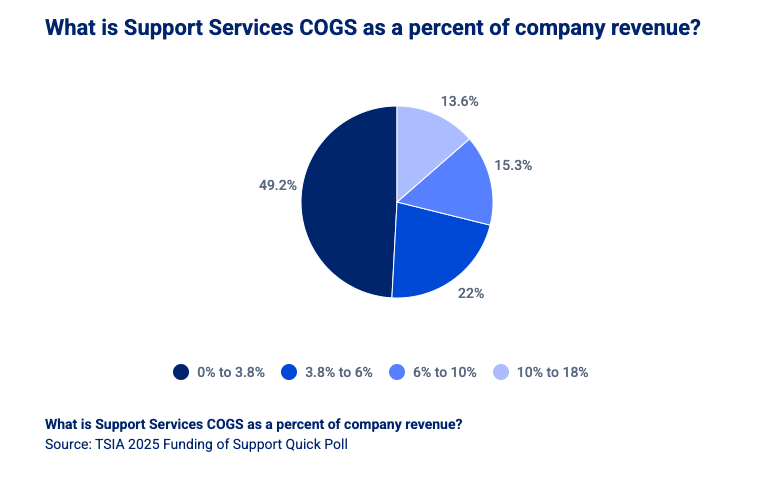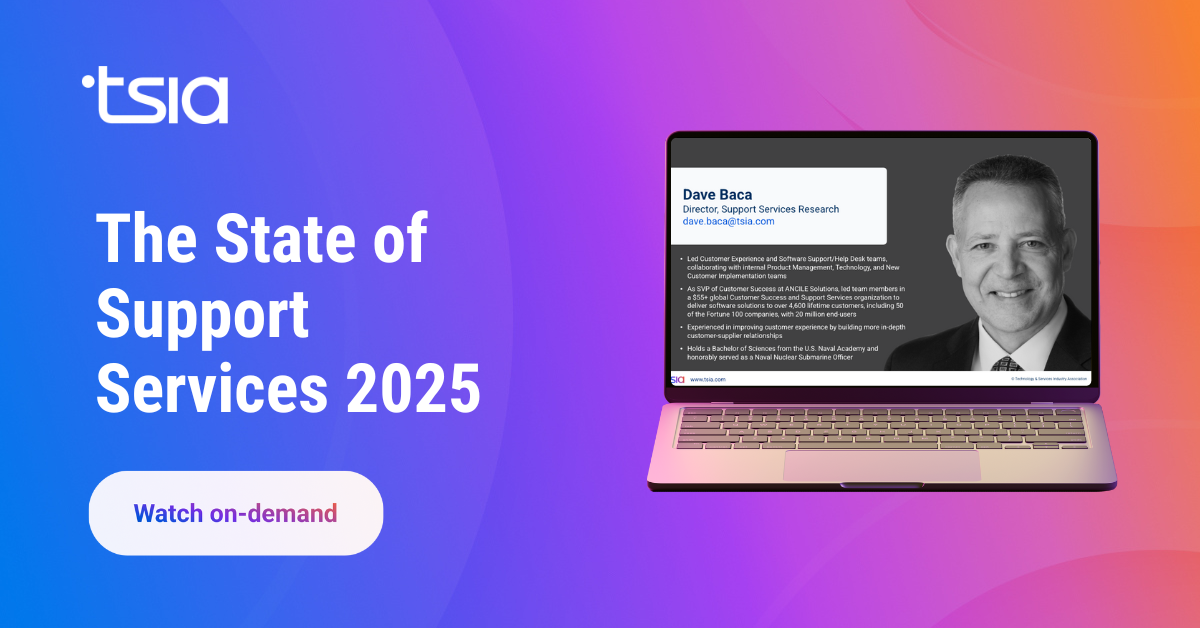If you’re leading a support services team, you know how many moving pieces there are—from managing support engineers and optimizing operations, to justifying costs and measuring AI effectiveness. But, what else are other support leaders focusing on right now?
To find out, we turned to TSIA Intelligence, the AI-powered tool in the TSIA Portal that reveals the most frequently asked questions from support leaders like you. In this blog, we’re sharing the top questions your peers are asking—and what you should know to stay ahead.
Whether you’re evaluating support performance, looking to fine-tune your metrics, or preparing for AI investments, these insights will help you make smarter, more strategic decisions.
Key Takeaways
- Measuring AI in support requires more than just CSAT: To track AI’s effectiveness, you need metrics across automation, resolution, customer experience, knowledge usage, and ROI, not just customer satisfaction scores.
- Support engineer performance metrics are evolving: Focusing on first contact resolution, escalation rates, and linked knowledge base usage gives you a more complete picture of productivity and customer impact.
- Support cost benchmarks vary, but underfunding can hurt: While many companies keep support costs below 4% of revenue, that may not be sustainable in XaaS models where support plays a critical role in long-term customer success.
What Metrics Should You Track To Measure AI Effectiveness in Support Services?
If you're integrating AI into your support services operations, tracking the right metrics is essential to understanding how well it’s working. AI has the potential to improve resolution times, reduce costs, and enhance customer satisfaction. But how do you measure that impact? Here are the core areas and key metrics you should focus on.
AI Automation and Case Resolution
AI can handle repetitive tasks and support tickets, but to honestly assess its effectiveness, keep an eye on:
- Automation rate: How many incidents are resolved entirely by AI without human help? A higher number means your AI is doing more of the heavy lifting.
- AI assistance rate: Even when AI doesn’t resolve a case on its own, it can help agents solve issues faster. This metric shows how often that’s happening.
- Explicit case deflection: When customers use self-service tools (like AI-powered chatbots or portals) and don’t end up needing human support, that’s a win. This metric tracks how often that occurs.
- Implicit case deflection: This looks at the cases that were likely prevented because your self-service resources were available in the first place.
- Self-service success: How often are customers finding answers on their own? This tells you how effective your AI-driven knowledge base is.
Customer Experience
AI should make things easier for your customers, not harder. To measure that, focus on:
- Customer satisfaction (CSAT): Track feedback after individual support interactions to gauge customer satisfaction.
- Customer effort score: This reveals how easy or difficult it is for your customers to resolve their issues. Less effort means a better experience.
Knowledge Management
Smart AI needs smart content. Your knowledge management program should track:
- Content creation rate: Are you producing new knowledge base articles regularly to support AI training and customer self-service?
- Content review frequency: Are your existing articles being reviewed and updated often enough to remain accurate and helpful?
Operational Efficiency
AI should help your team do more in less time. Be sure to track:
- Resolution time: Are cases being closed faster thanks to AI assistance?
- Agent efficiency: Are your support agents handling calls and resolving issues more quickly and effectively with AI in the mix?
ROI and Cost Savings
Finally, AI should be delivering real business value. Key metrics include:
- Labor cost reduction: Are you seeing savings from fewer manual tasks and more automation?
- Increased service capacity: Can your team now handle more diverse requests overall, thanks to AI?
Related: Leveraging AI to Enhance Customer Experience and Efficiency
How Much Should Support Cost as a Percentage of Revenue?
One of the most common questions support leaders ask is: How much should support cost relative to company revenue? The answer isn’t one-size-fits-all, but understanding industry benchmarks can help you evaluate where you stand—and where you may need to adjust.
Support Cost Benchmarks
According to TSIA data, here’s how companies are currently spending on support services as a percentage of total revenue:
- 49% of companies report that their support cost of goods sold (COGS) falls between 0% and 3.8% of revenue.
- 22% fall into the 3.8% to 6% range.
- 13.6% report support costs between 10% and 18%—a much higher slice of the revenue pie.
This wide range shows that while many organizations operate with relatively low support costs, others—especially those in more service-intensive or complex environments—see much higher percentages.

Why This Metric Matters
Tracking the cost of support as a percentage of revenue is critical, particularly if you're shifting to a technology-as-a-service (XaaS) model. In these models, support plays a bigger role in long-term customer satisfaction and retention, which means underfunding support (e.g., keeping it below 4% of revenue) can undermine long-term growth strategies.
If you're operating in a recurring revenue model, it’s worth taking a hard look at whether your support investments are aligned with your customer needs and your business goals.
Related: TSIA Support Services Benchmarking
What Metrics Should You Use To Measure Support Engineer Performance?
To keep your support team running efficiently and delivering great customer experiences, it’s essential to measure how well your support engineers are performing. The right metrics can show you where things are going well—and where there’s room to grow.
Here are the key performance metrics you should be tracking:
- Transactional customer satisfaction (CSAT score): After each interaction, ask your customers how satisfied they were with the support experience. This score gives you a direct view into how your engineers are performing in the eyes of your customers. The more satisfied your customers are, the stronger your engineer's impact on service quality.
- First contact resolution rate (FCRR): FCRR tells you how often an engineer resolves a customer issue during the first interaction. Higher rates mean fewer follow-ups, faster resolution, and happier customers.
- Mean time to resolution (MTTR): MTTR tracks how long it takes on average to resolve support cases. Lower MTTR shows your engineers are efficient at identifying and resolving the root cause quickly.
- Escalation rate: This metric reveals how often your engineers need to escalate issues to higher-level teams. A lower escalation rate means your engineers are skilled at solving complex problems themselves.
- Knowledge management (KM) usage: Are your engineers using and referencing your knowledge base effectively? A higher rate indicates that they’re tapping into existing content to resolve issues more efficiently and consistently.
- Average daily cases worked per engineer: This helps you gauge overall productivity. Just remember—more cases aren’t always better if it leads to burnout. Balance is key.
- Engineer utilization rate: This metric shows how much of your engineers’ time is spent on billable or productive work. A high utilization rate can indicate efficient use of time, but it should also be evaluated alongside quality and customer satisfaction.
Related: How to Build a Successful Knowledge Management Program

What These Support Services Insights Mean for You
The questions highlighted in this blog represent the top challenges support leaders like you are actively trying to solve, ranging from how to track AI’s impact to understanding support costs and measuring team performance.
By staying curious and asking the right questions, you can continuously improve your support strategy, enhance customer satisfaction, and drive efficiency. And with TSIA Intelligence, you don’t have to guess what to do next—you can get data-backed answers from a source built for support services professionals.
Frequently Asked Questions
What is TSIA Intelligence?
TSIA Intelligence is an AI-powered search engine built into the TSIA Portal that allows you to ask real-time business questions and get answers backed by TSIA’s data, benchmarks, and research. It’s designed for leaders across all technology services functions, including support services.
Can TSIA Intelligence help me measure AI effectiveness in support?
Yes. TSIA Intelligence can guide you to the right metrics—such as automation rate, case deflection, and customer effort score—to help you assess how well AI is performing within your support organization.
How can TSIA Intelligence help me prioritize improvements in support services?
TSIA Intelligence highlights the top questions support leaders are asking and provides data-backed answers to help you identify performance gaps, set priorities, and make informed decisions to improve your support operations.
Smart Tip: Embrace Data-Driven Decision Making
Making smart, informed decisions is more crucial than ever. Leveraging TSIA’s in-depth insights and data-driven frameworks can help you navigate industry shifts confidently. Remember, in a world driven by artificial intelligence and digital transformation, the key to sustained success lies in making strategic decisions informed by reliable data, ensuring your role as a leader in your industry.














